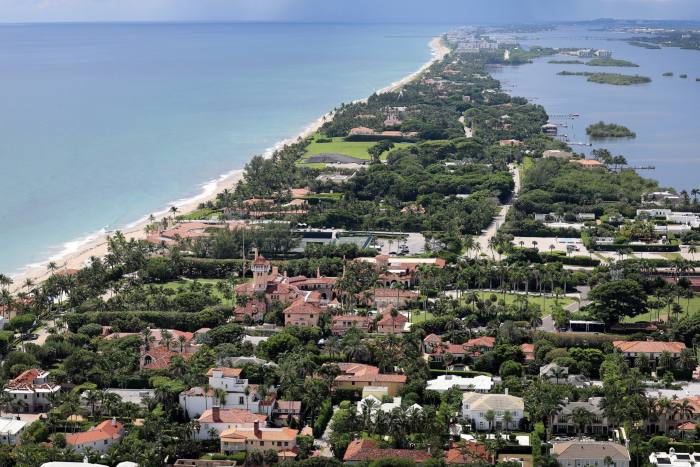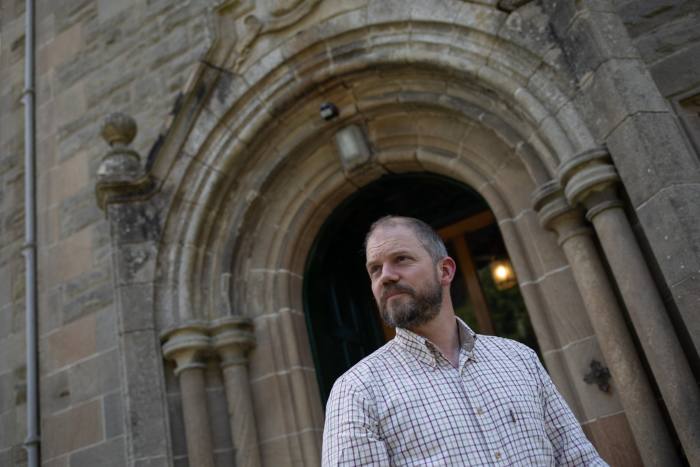Ten days before Jon McCosh was due to renew the insurance on a farmhouse he rented out on his Scottish family estate, it burnt down. The insurer has agreed to pay the full £306,000, for which the building was insured, but after a year of inflation in construction materials and labour, the actual cost of rebuilding it will be roughly £450,000.
There was nothing he could have done, says McCosh, 46, a trained chartered surveyor, who manages the estate full time. “Nobody goes back and revisits an estimate halfway through the year — it’s just not feasible on a large estate like this, with so many buildings. We’d taken all reasonable steps to insure the building correctly one year earlier but we ended up underinsured.”
A combination of high inflation and a string of natural disasters has rapidly increased the costs, administration and potential losses when insuring all kinds of high-end properties, as well as the contents and collections they house.
Since the start of the pandemic, average premiums on US homes worth more than $1mn have increased by 30 per cent, according to Michel Leonard, of the Insurance Information Institute, a US insurance research provider. Over the past year alone, premiums for high-value homes in the UK have risen 20 per cent, according to Weatherbys Hamilton, a UK insurance broker.
Insurers are also asking more questions and excluding more items, and policies are taking longer to arrange, says Jack Frost, of the farm and estate division at Weatherbys Hamilton. “Insurers are becoming more risk-averse, questioning in a lot more detail the risk that we are asking them to insure. It’s not only [for] a new request — it might be a straightforward renewal on a HNWI [high-net-worth individual’s] house.”
Reeling from large payouts and harder terms in the reinsurance market, where they lay off their risk, insurers are pulling back. In May, Allianz closed its Home & Legacy brand, one of the leading providers of insurance for the wealthy in the UK. Those that remain are increasing prices and reducing their cover, says Charles Foster, chief executive of Lycetts, the UK insurance broker.
“Their response has been to increase premiums to produce cash and to tighten terms, restrict cover and increase excesses,” he says.
Brokers are having to work harder to find the coverage expected by customers, who face increasing checks and a longer policy document, containing more detailed exceptions.
Alexander Kraft lives mainly in Monaco but has to insure homes in Provence, Paris, Florence and Berlin, as well as a number of collections including classic cars, art, watches and 18th-century furniture.
“No matter where your home is, premiums have gone up,” he says. “I have to furnish more documentation and, across the board, policies have been modified: they are much longer, with more fine print in them, even for a supposedly simple insurance.”
The slew of recent floods, storms and wildfires has increased premiums disproportionately for properties in vulnerable locations, according to Scott Teller, US executive underwriting officer at insurer Chubb, which claims to be the largest broker for the wealthy in the US.
“It has been a perfect storm of variables with inflation driving [rebuilding] values up for property and increased [natural] catastrophes,” he says. “If you’re moving into a high wildfire area in California, you’ll be paying significantly more — if you can even find coverage.”
In the US, rates for property catastrophe in the reinsurance market, which provides cover to insurers for natural disaster losses such as hurricanes and fires, increased by between 45 per cent and 100 per cent for loss‑hit policies, at the start of this year, according to figures from Gallagher Re, a reinsurance broker, published in January.


Many of the most popular home locations in the US for the very rich — including the Hamptons in New York, Florida’s Palm Beach and southern California’s Orange County — are at risk from flooding or wildfire.
“Ultra-HNWIs do like their scenic view at the water, up in the mountains or at the ski resort,” notes Teller. “So they put themselves in places where there is a higher risk of catastrophe.”
Following the pandemic, the popularity of such homes has increased. One in four of Chubb’s wealthy clients bought a second or additional home after the outbreak of Covid-19, seeking rural or less congested areas to live, according to Teller.
As insurers become more selective about the risks they take on, many large old homes are also becoming more difficult and more expensive to insure. Nicola Waite, head of individual business at Monaco insurance broker Jutheau-Husson, says that 80 per cent of her clients have large homes in the surrounding French countryside — often large, historic buildings — in addition to a main residence in the principality.
“Castles, in particular, are getting harder to insure,” she says. “The contents are low value — and so of little interest to insurers — and often they are very old buildings that are not in the best state.”
The expanding collections of the wealthy are also presenting an insurance challenge. According to Knight Frank’s annual survey of bankers and other advisers, one in four very wealthy people increased their spending on collectibles in 2021. In 2022, 5 per cent of their wealth was invested this way, according to the company.
“Following Covid, with more time spent at home, many people filled gaps in existing collections and started new collections of watches, wines and spirits, luxury handbags, sports memorabilia and so on,” says Laura Doyle, head of Chubb’s fine art and valuable collections business in New York, who notes that the growth of online purchases by collectors since the start of the pandemic has increased insurers’ scrutiny of items’ authenticity.
Annual premiums for collectibles
-
Between £35,000 and £50,000 for a £50mn art collection, according to HDI Global Specialty, an international insurer.
-
Roughly £140,000 for a stable of flat racehorses with a combined value of £5mn, according to Lycetts.
-
£4,000-£5,000 for a classic car collection worth £2.5mn, according to Classic Insurance Services. The annual mileage has to be low and the cars must be securely garaged.
But the premiums to insure high-value items are increasing and restrictions on their use are tightening, says Waite, who points to supercars. “On higher-value cars, insurers are asking for specialist trackers on the vehicles — those fitted by the manufacturers aren’t acceptable. But some customers don’t like the idea of being tracked,” she says.
Foster says he is spending more time persuading insurers to drop unreasonably tight requirements in policies. One of his clients has a home in Chelsea, London, which his family uses during the week, and a country home for the weekends, each of which contains art collections worth more than £20mn. Recently, the insurer asked that each home should be fully staffed at all times to increase security. This would add, Foster estimates, £100,000 in annual staffing costs to the family — significantly more than the £60,000 premium cost.
“We pushed back,” he says. “Clearly, they can’t live in both homes at once — it was punitive and not realistic.”
Facing these more stringent conditions and higher premiums, many are opting to self-insure. Waite says, this year, more of her clients who own supercars have opted to buy only the cover required by law. Kraft self-insures his watch collection after he learnt he was not covered for a recent theft. “I had a break-in and, as per Murphy’s law, it was a day when I had taken several watches out of the safe and not put them back,” he says.

After 12 of his 60 watches — each of which is worth between €20,000 and €500,000 — were stolen, he learnt that his policy only covered two watches stolen from outside his safe. “I’d paid annual premiums in the five figures for more than a decade for insurance that was useless in the form I had taken,” he says.
For insured items, customers must be alert to increasing valuations or risk being underinsured. Sarah Willoughby, art and private client director at Ecclesiastical Insurance in the UK, advises clients to revalue fast-appreciating items, including jewellery and watches, every three years, and those with more stable values, including fine art, porcelain and antiques, every five.
Without an up-to-date valuation, clients may receive less in the event of a claim, she says. “It is their responsibility that they are insuring items for the correct value.”
Flash floods in central London in July 2021 showed the risk attached to basements — an increasingly common feature of the capital’s high-value homes — and what was kept in them.
“Storing collections has come under increasing scrutiny: it might sound ridiculous but, if you have a fine art collection, don’t put [it] in a subterranean environment,” says Annmarie Camp, head of personal risk services for Chubb in Europe. She points to Hurricane Sandy, in 2012, when surge water destroyed works in galleries and art warehouses across New York worth hundreds of millions of dollars.
Underground garages, beloved of the super-rich to store classic-car and supercar collections, are also hazardous, according to Hannah Cloke, professor of hydrology at the University of Reading. “You can move the cars if there is enough warning but, for sudden heavy bursts of rainfall, you may not have time,” she says. “People often die trying to rescue property.”
She is being approached increasingly by insurers from around Europe, seeking to understand extreme weather events, such as the floods in Germany in 2021 which killed more than 180 people. But accurate prediction is hard, she says.
“The floods in Germany shocked the insurers and reinsurers — they are asking many more questions about the nature of that changing risk. But flooding from intense rainfall bursts are hard to pin down with our computer models,” she says.

Back in Scotland, McCosh faces other challenges besides rebuilding the farmhouse destroyed by fire in February. The insured value on the estate’s main property — a sprawling eight-bedroomed stone house, built in 1881, in which he lives with his family — doubled when it was revalued a few months ago to several million pounds; his premium has increased from £1,066 to £2,622.
For properties he uses for short lets, he has been unable to get insurance to cover guest cancellation because of illness, since early in the pandemic. A rolling programme of retrofitting and refurbishing the estate’s rental accommodation, to comply with Scotland’s energy performance certificate (EPC) requirements, means that some of his rental homes are unoccupied. These ones are now much harder to insure, he says.
“For some, the premiums for these buildings are doubling, or we’ve had to go to a specialist insurer. For vacant buildings, insurers are getting niggardly.”
He will have to find £150,000 if he is to rebuild the destroyed farmhouse. But he is relieved it is not more: the insurer tried to argue that only a partial rebuild was required, meaning it would have paid out only part of the sum insured.
Today, more than ever, it is crucial to find a good insurance broker, who will advocate on behalf of a client in the case of such disagreements, he says.
“The best brokers accept your commitment and go into battle on your behalf. Others will sit on the fence between you and the insurer.”
But he says that, with inflation high and insurers skittish, there are some risks — such as recent rampant inflation in rebuilding costs — that brokers can’t help with.
“It was a cautionary tale in how easy it is to find yourself underinsured without decent reason.”
This article is part of FT Wealth, a section providing in-depth coverage of philanthropy, entrepreneurs, family offices, as well as alternative and impact investment












